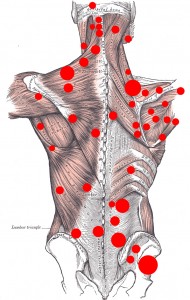 Neuromuscular Therapy
Neuromuscular Therapy
Neuromuscular therapy is a technique using pressure on specific points to relieve pain. It helps recalibrate nerve impulses to the brain, decreasing the number of pain impulses the brain receives.
A neuromuscular therapy massage is applied in various pressures by the therapist, using a combination of effleurage or gliding, petrissage or grasping, friction, muscle energy, and strain, counter-strain techniques.
First the therapist will locate the muscle spasm in the back and then concentrate the hands-on treatment to this area by applying continuous pressure for about 30-seconds with their fingers, knuckles and elbows. The same pressure must be maintained by the massage therapist for the entire 30-seconds in order to encourage proper blood flow in the area.
Typically, painful muscle spasms occur when our muscles lack adequate blood flow. When this occurs, lactic acid accumulates in the muscle. Anyone who has worked out will be familiar with the formation of lactic acid in muscles – it accumulates in, and causes soreness in muscle tissue following a strenuous workout. Neuromuscular therapy is applied on this same principal. It disperses the lactic acid, so the deficient muscle can begin to accept a clean supply of oxygen and blood flow.
During your first neuromuscular therapy session, you may be surprised when you feel some discomfort and pain during the massage. This is normal at first, and as the massage therapist adds more pressure to their stroke the muscle spasm will melt away. After a few neuromuscular therapy massages, clients will often claim that the pressure was painful, but in a good way. Typically, before a neuromuscular therapy massage begins, the practitioner will tell the client to alert them immediately if the pressure is painful. The therapist will often check in with their client during the massage to ask if the stroke pressure is too light, too hard, or comfortable. The therapist will then adjust their pressure according to their clients verbal cues.
Often clients will experience some muscle soreness following a neuromuscular therapy massage. However, like with exercise, the muscle soreness will disappear within a few days and the clients body will feel more relaxed for typically about a week following the treatment.
